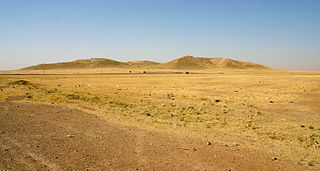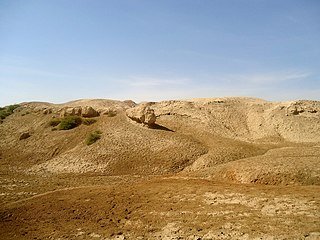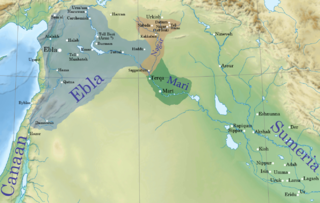
Dagon or Dagan was a god worshipped in ancient Syria across the middle of the Euphrates, with primary temples located in Tuttul and Terqa, though many attestations of his cult come from cities such as Mari and Emar as well. In settlements situated in the upper Euphrates area, he was regarded as the "father of gods" similar to Mesopotamian Enlil or Hurrian Kumarbi, as well as a lord of the land, a god of prosperity, and a source of royal legitimacy. A large number of theophoric names, both masculine and feminine, attests that he was a popular deity. He was also worshiped further east, in Mesopotamia, where many rulers regarded him as the god capable of granting them kingship over the western areas.

Yamhad (Yamḫad) was an ancient Semitic-speaking kingdom centered on Ḥalab (Aleppo) in Syria. The kingdom emerged at the end of the 19th century BC and was ruled by the Yamhad dynasty, who counted on both military and diplomacy to expand their realm. From the beginning of its establishment, the kingdom withstood the aggressions of its neighbors Mari, Qatna and the Old Assyrian Empire, and was turned into the most powerful Syrian kingdom of its era through the actions of its king Yarim-Lim I. By the middle of the 18th century BC, most of Syria minus the south came under the authority of Yamhad, either as a direct possession or through vassalage, and for nearly a century and a half, Yamhad dominated northern, northwestern and eastern Syria, and had influence over small kingdoms in Mesopotamia at the borders of Elam. The kingdom was eventually destroyed by the Hittites, then annexed by Mitanni in the 16th century BC.

Ebla was one of the earliest kingdoms in Syria. Its remains constitute a tell located about 55 km (34 mi) southwest of Aleppo near the village of Mardikh. Ebla was an important center throughout the 3rd millennium BC and in the first half of the 2nd millennium BC. Its discovery proved the Levant was a center of ancient, centralized civilization equal to Egypt and Mesopotamia and ruled out the view that the latter two were the only important centers in the Near East during the Early Bronze Age. The first Eblaite kingdom has been described as the first recorded world power.

Mari was an ancient Semitic city-state in modern-day Syria. Its remains form a tell 11 kilometers north-west of Abu Kamal on the Euphrates River western bank, some 120 kilometers southeast of Deir ez-Zor. It flourished as a trade center and hegemonic state between 2900 BC and 1759 BC. The city was built in the middle of the Euphrates trade routes between Sumer in the south and the Eblaite kingdom and the Levant in the west.

Išḫara was a goddess originally worshipped in Ebla and other nearby settlements in the north of modern Syria in the third millennium BCE. The origin of her name is disputed, and due to lack of evidence supporting Hurrian or Semitic etymologies it is sometimes assumed it might have originated in a linguistic substrate. In Ebla, she was considered the tutelary goddess of the royal family. An association between her and the city is preserved in a number of later sources from other sites as well. She was also associated with love, and in that role is attested further east in Mesopotamia as well. Multiple sources consider her the goddess of the institution of marriage, though she could be connected to erotic love as well, as evidenced by incantations. She was also linked to oaths and divination. She was associated with reptiles, especially mythical bašmu and ḫulmiẓẓu, and later on with scorpions as well, though it is not certain how this connection initially developed. In Mesopotamian art from the Kassite and Middle Babylonian periods she was only ever represented through her scorpion symbol rather than in anthropomorphic form. She was usually considered to be an unmarried and childless goddess, and she was associated with various deities in different time periods and locations. In Ebla, the middle Euphrates area and Mesopotamia she was closely connected with Ishtar due to their similar character, though they were not necessarily regarded as identical. In the Ur III period, Mesopotamians associated her with Dagan due to both of them being imported to Ur from the west. She was also linked to Ninkarrak. In Hurrian tradition she developed an association with Allani.
Irkab-Damu, was the king (Malikum) of the first Eblaite kingdom, whose era saw Ebla's turning into the dominant power in the Levant.

Tell Brak was an ancient city in Syria; its remains constitute a tell located in the Upper Khabur region, near the modern village of Tell Brak, 50 kilometers north-east of Al-Hasaka city, Al-Hasakah Governorate. The city's original name is unknown. During the second half of the third millennium BC, the city was known as Nagar and later on, Nawar.

According to a theory proposed by Ignace Gelb, the Kish civilization encompassed the sites of Ebla and Mari in the Levant, Nagar in the north, and the proto-Akkadian sites of Abu Salabikh and Kish in central Mesopotamia in to the early East Semitic era in Mesopotamia and the Levant. The epoch began in the early 4th millennium BC and ended with the rise of the Akkadian empire. The theory has been discarded by more recent scholarship.
Iblul-Il, was the most energetic king (Lugal) of the second Mariote kingdom, noted for his extensive campaigns in the middle Euphrates valley against the Eblaites, and in the upper Tigris region against various opponents, which asserted the Mariote supremacy in the Syrian north.
Kun-Damu was a king (Malikum) of the first Eblaite kingdom ruling c. 2400 BC. The king's name is translated as "Arise, O Damu". Kun-Damu is attested in the archives of Ebla dated two generations after his reign. According to Alfonso Archi, he was a contemporary of Saʿumu of Mari. The archives of Ebla records the defeat of Mari in the 25th century BC, and based on the estimations for his reign, Kun-Damu might be the Eblaite king who inflicted this defeat upon Mari. Aleppo might have came under the rule of Ebla during his reign. Following his death, he was deified and his cult was attested in Ebla for at least 30 years after his reign.

Igrish-Halam or Igriš-Halab, was a king of the ancient city state of Ebla. His name means "(The god of) Halab has driven away ", hence, the name might be a commemoration of an Eblaite victory that led to the incorporation of lands beyond the city of Halab.
Hadabal was a god worshiped in Ebla and its surroundings in the third millennium BCE. He was one of the main gods of that area, and appears frequently in Eblaite documents. His character is not well understood, though it has been proposed that he might have been an agricultural or lunar god. Like the city's tutelary god Kura and his wife Barama, he is absent from sources postdating the destruction of Ebla.
Kura was a god worshiped in Ebla in the third millennium BCE. He was the tutelary god of the city, as well as the head of the local pantheon. While his functions are difficult to ascertain, it is well attested that he was connected to the institution of kingship.
Adamma was a goddess worshiped in Ebla in the third millennium BCE, later also documented in Hurrian sources and in Emar. The origin and meaning of her name remain a matter of debate among researchers. It is commonly assumed that it originated in one of the Semitic languages and that it can be compared to Hebrew ʾădāmâ, "soil" or "earth". An alternate view is that it belongs to a linguistic substrate at some point spoken in part of modern Syria. Hurrian origin has been proposed as well, but is considered implausible. In Ebla, Adamma received sacrificial sheep on behalf of the royal palace. She also had clergy of her own, as evidenced by references to a dam-dingir priestess in her service. Eblaite texts indicate she was also venerated in Hadani and Tunip. She was locally regarded as the spouse of Resheph, though the connection between them is not attested in later sources. After the fall of Ebla, she was incorporated into Hurrian religion, and in this context appears in Hittite and Ugaritic sources as well, often forming a pair with Kubaba. Furthermore, she was worshiped in Emar, where under the name Adammatera she might have been perceived as a deity associated with storage areas and the underworld. It is also possible that the goddess Admu known from Mari and from the Mesopotamian god list An = Anum was the same deity.
Shalash (Šalaš) was a Syrian goddess best known as the wife of Dagan, the head of the pantheon of the middle Euphrates area. She was already worshiped in Ebla and Tuttul in the third millennium BCE, and later her cult is attested in Mari as well. She was also introduced to the Mesopotamian and Hurrian pantheons.
Saggar was a god worshiped in ancient Syria, especially in the proximity of Ebla and Emar, later incorporated into the Hurrian and Hittite pantheons. His name was also the ancient name of the Sinjar Mountains. It is assumed that he was at least in part a lunar deity.
Barama was a goddess worshiped in the Syrian city of Ebla in the third millennium BCE as the wife of its tutelary god, Kura. She is not attested from any sources postdating the destruction of the city.
Ammarik, also transcribed as Ammarig or Hammarigu, was a god worshiped in Ebla in the third millennium BCE. He was most likely a deified mountain.









